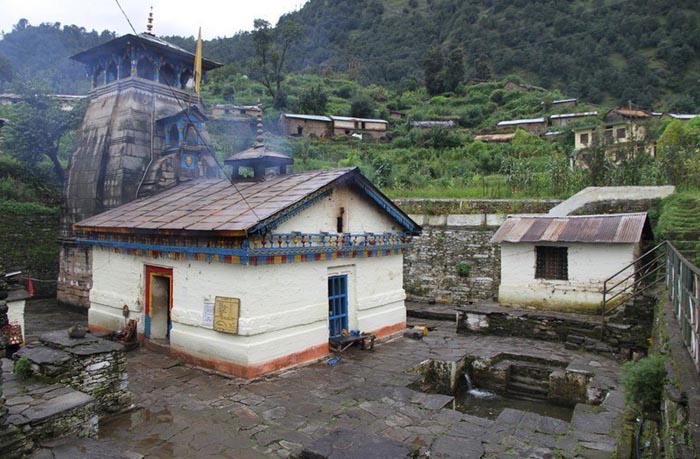Triyuginarayan Temple

Information of Triyuginarayan Temple, Rudraprayag, Uttarakhand
Triyuginarayan Temple is the place where the Lord Shiva and Parvathi Devi's marriage took place in the ancient times. It is a very important Hindu pilgrim place located near the river confluence of Mandhakini and Ganges River. It is located centrally in the Gharral Hindu pilgrim circuit center, where many pilgrims have to cross by this famous temple along with the picturesque beauty of the lower Himalayas of the Shivalik Ranges. From here the view of the upper Himalayas are very magnificent to look. This mountain group belongs to the Gharwal region. This is an ancient temple with many religioustic values and historical importance. This is totally a stone temple beautifully located at Rudraprayag District, Uttrakhand State of India. The temples is well known and is draws the attention of huge number of devotees as well as visitor round the year.
Triyuginarayan Temple Religious Significance
Triyuginarayan Temple is believed to be a temple of cosmic marriage. Here Lord Shiva wedded Parvathi Devi in the Tretha Yuga on the lower Himalayan range. This marriage was witnessed by the trinity of Hindu gods named the Maha Vishnu, Brahma Dev and the Maheshwara. That's why the temple name acquired here as the Triyuginarayan Temple. Here the primary ditties are Lord Vishnu, Shiva and Parvathi Devi can be worshiped at one place. This temple is as holy as the cosmic marriage. Still the ritual fire lit on the ceremonial function of the cosmic marriage is burning non sop by its devotees. Every devotees visiting here will offer fire woods to make it an Akand Jyothi or the perpetual fire. Visiting this divine and holy place is of great importance for the Hindus in India and abroad. There are also idols of Hanuman Dev, Shree Vinayaka and the Annapurna Devi. There are three Khunds here from where all devotees used to wash their feet before entering this temple. These Kunds are also having very good mineral properties in their water and fit for drinking. Many pilgrims come here to see this divine place of Gods importance on this earth. Many devotees do come here and pray for getting them married soon.
Festivals at Triyuginarayan Temple
The Navarathi is its main festival conducted in this temple. Many of the panch kedhar pilgrims come here to witness this important event. This is very grandly conducted by its villagers. This festival takes place for two weeks and is filled with devotees. There are many special rituals and ceremonies conducted here on the festival times.
Triyuginarayan Temple Mythology & History
As per Vedic Texts and the Skanda puranas, this was the place where the Supreme Being lord Shiva married the daughter of the mountains, the Parvathi Devi. This was witnessed by the Trinity of the Hindu gods like Vishnu, Bhrams and the Maheshwara. There are many sculptures, stone arts and paintings depicting this event in the ancient times. There is also a Garuda idol in this temple; it was believed that lord Shiva ascended from the Heavens by travelling with Garuda. The importance of this place was later propagated by the famous Hindu Sage named the Adhi Shankara in the 8th century AD. Since then this Triyuginarayan Temple became popular towards the plain-lands of the Indian sub continent. Previously it was only worshiped by the Himalayan tribal peoples and few Northern regions those who were aware of importance of this holy place.
Triyuginarayan Temple Architectural Significance
Triyuginarayan Temple is there from the ancient times since the Lord Shiva and Parvathi wedding took place here. It was later developed to a huge temple by the efforts of a Hindu Sage of the 8th Century AD named the Adhi Shankara. This new temple which is seen today is found in the Nagra style of Hindu temples of those normally found in the North Indian temples. There is a main tower built of granite stones with a projected medium sized tower from the same main tower. This is an important style found in the Himalayan temples. In front of this temple there is a small traditional Gharwal home type structure built which is the main entrance. The important feature of this temple is that it has got three fresh water ponds named the Swarswathi Khund, the Bhrama khund and the Rudhra Khund. There is also an Agni Khund or the pond of perpetual fire. Its primary deities are the Lord Shiva and Parvathi along with Maha Vishnu. There are also beautiful idols of the Garuda, Hanuman and Vinayaga gods. This is a holy temple of historic and religious importance built at an altitude of 1980 meters above the mean sea level. This temple is looking more divine along with the banks of Songanga and Mandakini River confluence.
- Andhra Pradesh Temples
- Assam Temples
- Bihar Temples
- New Delhi Temples
- Goa Temples
- Gujarat Temples
- Jammu and Kashmir Temples
- Karnataka Temples
- Kerala Temples
- Madhya Pradesh Temples
- Maharashtra Temples
- Odisha Temples
- Punjab Temples
- Rajasthan Temples
- Sikkim Temples
- Tamil Nadu Temples
- Telangana Temples
- Uttar Pradesh Temples
- Uttarakhand Temples
- West Bengal Temples